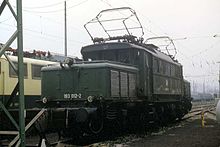DR series E 93
| DR class E 93 DB class 193 |
|
|---|---|
|
Monument locomotive 193 008
|
|
| Numbering: | DR E 93 01-18 DB 193 001-018 |
| Number: | 18th |
| Manufacturer: | AEG |
| Year of construction (s): | 1933-1939 |
| Retirement: | 1984 |
| Axis formula : | Co'Co ' |
| Gauge : | 1435 mm ( standard gauge ) |
| Length over buffers: | 17,700 mm |
| Service mass: | 117.2 / 117.6 * t |
| Wheel set mass : | 19.6 / 19.7 * t |
| Top speed: | 65/70 * km / h |
| Hourly output : | 2,502 kW |
| Continuous output : | 2,214 kW |
| Starting tractive effort: | 353 kN |
| Performance indicator: | 21.3 kW / t |
| Power system : | 15 kV 16 2 / 3 Hz ~ |
| Power transmission: | Overhead line |
| Number of traction motors: | 6th |
| Drive: | Paw camp |
| Brake: | Air brake |
| Train control : | Sifa |
| Particularities: | * E 93 05-18 |
The electric locomotives of the E 93 series (from 1968: DB series 193 ) with the nickname German Crocodile were designed for freight train service. Externally, the E 93 looks very similar to its successor series E 94 thanks to the "crocodile nose"; however, it lacks the distinctive perforated solebars of the E 94.
history
The electrification of the Geislinger Steige in 1933 on the Stuttgart - Ulm route required high-performance freight locomotives. The Reichsbahn requested a six-axle bogie locomotive without running axles. It should be able to transport freight trains with up to 1,600 tons to Geislingen- West and further along the Geislinger Steige together with a pushing locomotive up to 1,200 tons. In the opposite direction, 1,100 tons were to be transported on the ramp from Ulm to Beimerstetten without a push-pull locomotive. The maximum speed was 65 km / h, which was the speed of express freight trains at the time.
Due to the positive experience with the test locomotive E 44 001 , the tatzlager drive was also chosen for the E 93 . The two three-axle bogies with attached buffer beam and the two fronts carried a welded bridge frame with the locomotive body, in which the main part of the electrical equipment and the two driver's cabs were housed. For the first time, a BBC safety driving gear was part of the standard equipment .
In 1933 AEG delivered E 93 01 and 02 to the Reichsbahn. The machines were stationed in Kornwestheim near Stuttgart and subjected to extensive testing there. From 1935 to the end of 1937, eleven more E 93s followed directly from the factory. The E 93 14-18 first came to the RBD Halle, but were relocated to Rosenheim in connection with the delivery of the E 94 . But even there they were soon replaced by the more powerful E 94.
Used by the Deutsche Bundesbahn
At the end of the war, Kornwestheim had six E 93s; others were stationed in the Ulm and Geislingen depots. Several E 93s were damaged by bombs and air fire, but in 1947 they were all back in service. In 1951, the entire Ulm stock was relocated to Kornwestheim, followed by the machines from Geislingen in 1958. With that, all E 93s were gathered in Kornwestheim, where they remained until their respective decommissioning.
The task area of the E 93 was mainly the transport of freight trains from Stuttgart to Munich, with the progressive electrification of the lines also to Würzburg, Nördlingen and Mannheim as well as the push service on the Geislinger Steige. With the start of deliveries of the E 50 , however, it slowly migrated to subordinate services.
The last years of use
From 1968 the E 93 were renamed the 193 series. In 1976 the Deutsche Bundesbahn deleted the 193 series from the maintenance inventory, and seven machines were taken out of service in the same year. However, pushing them along the Geislinger Steige remained their domain until the end. The 193 006 was the last to be parked in June 1984.
Whereabouts
Three class 193 locomotives have been preserved:
- 193 007 as the official DB AG museum locomotive,
- 193 008 as a memorial on the site of the Neckarwestheim nuclear power plant (see picture in the info box),
- 193 012 was transferred to Ettlingen for refurbishment on wheels and placed in an operating hall of the Albtal-Verkehrs-Gesellschaft mbH , it is currently still in a desolate condition.
literature
- Horst J. Obermayer: Paperback German electric locomotives . Franckh'sche Verlagshandlung, Stuttgart 1970; ISBN 3-440-03754-1

